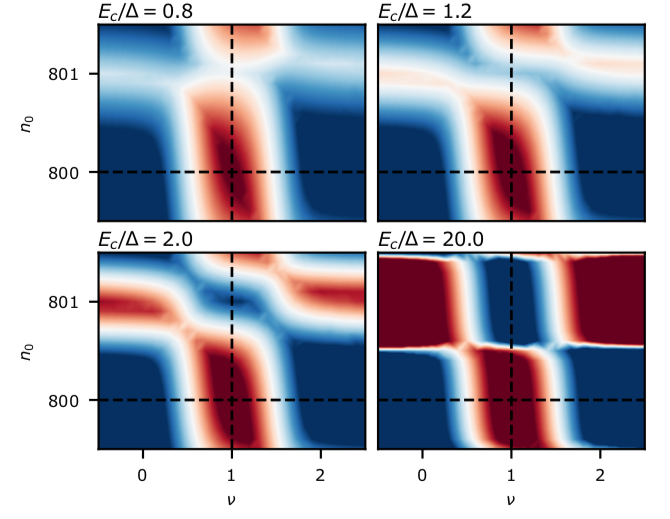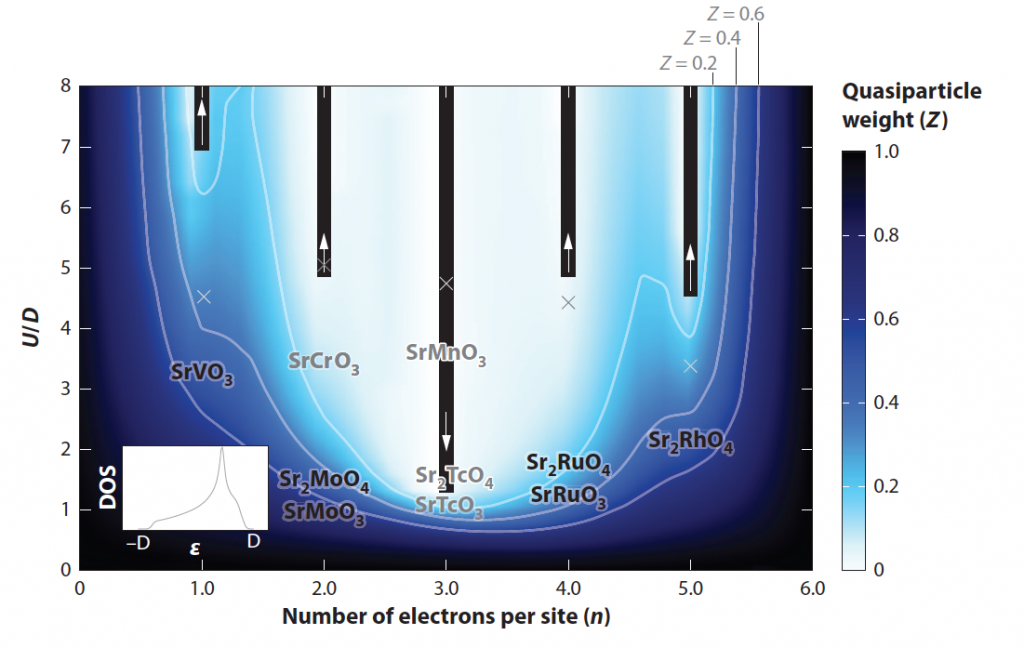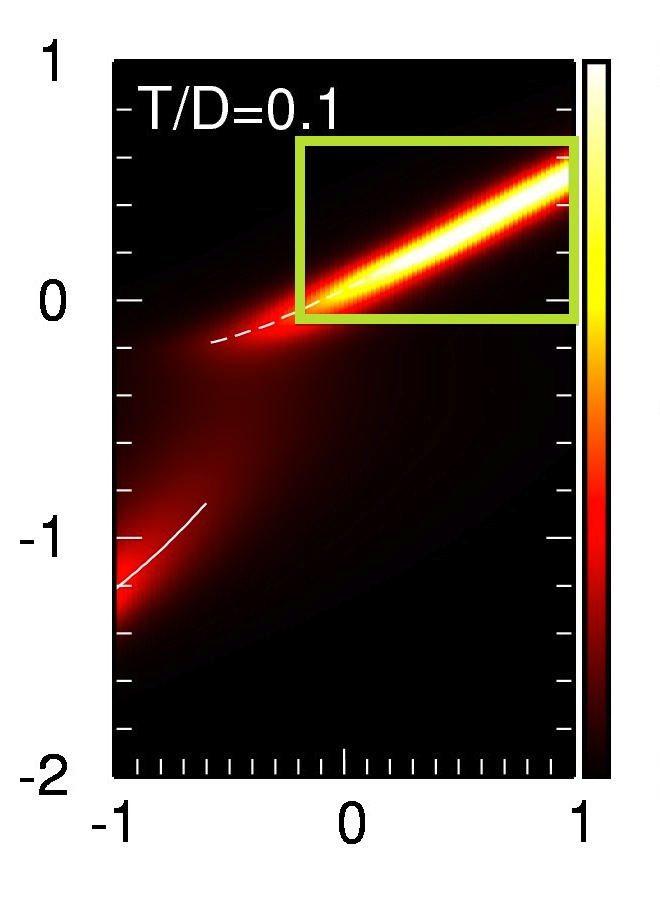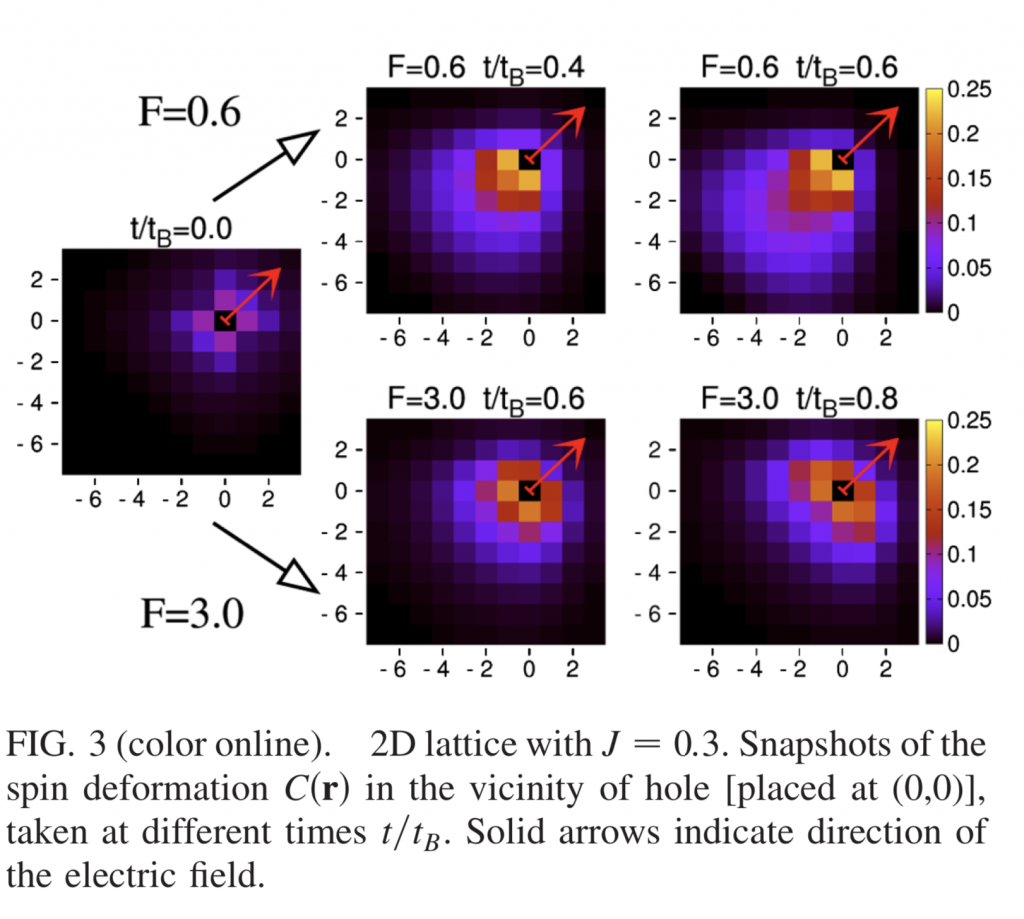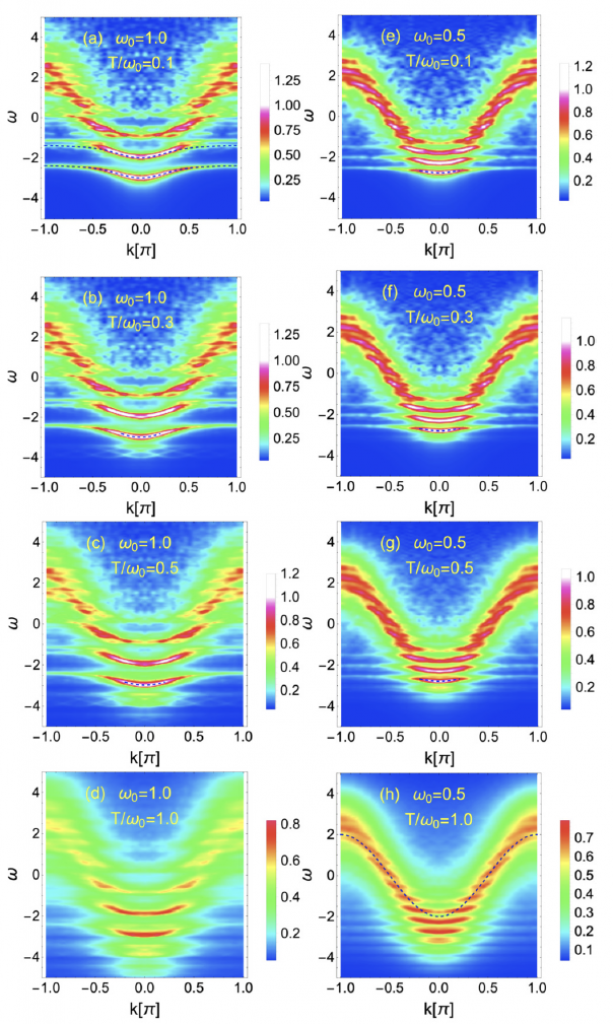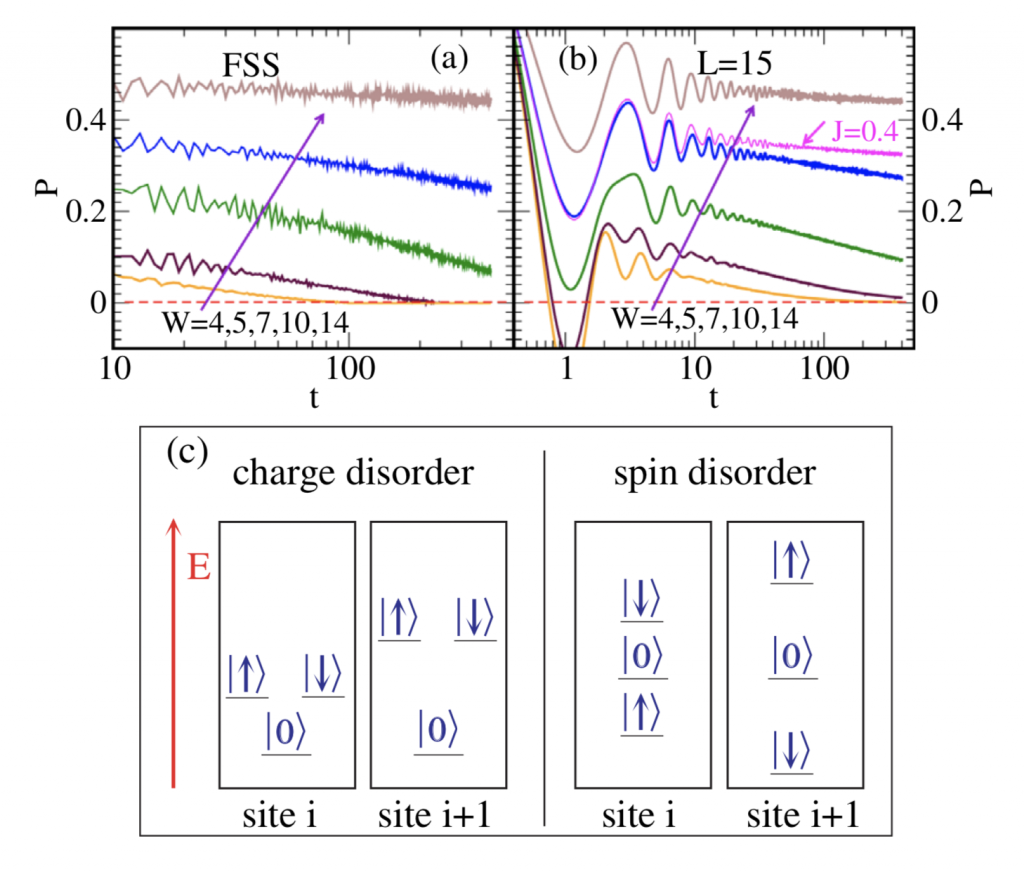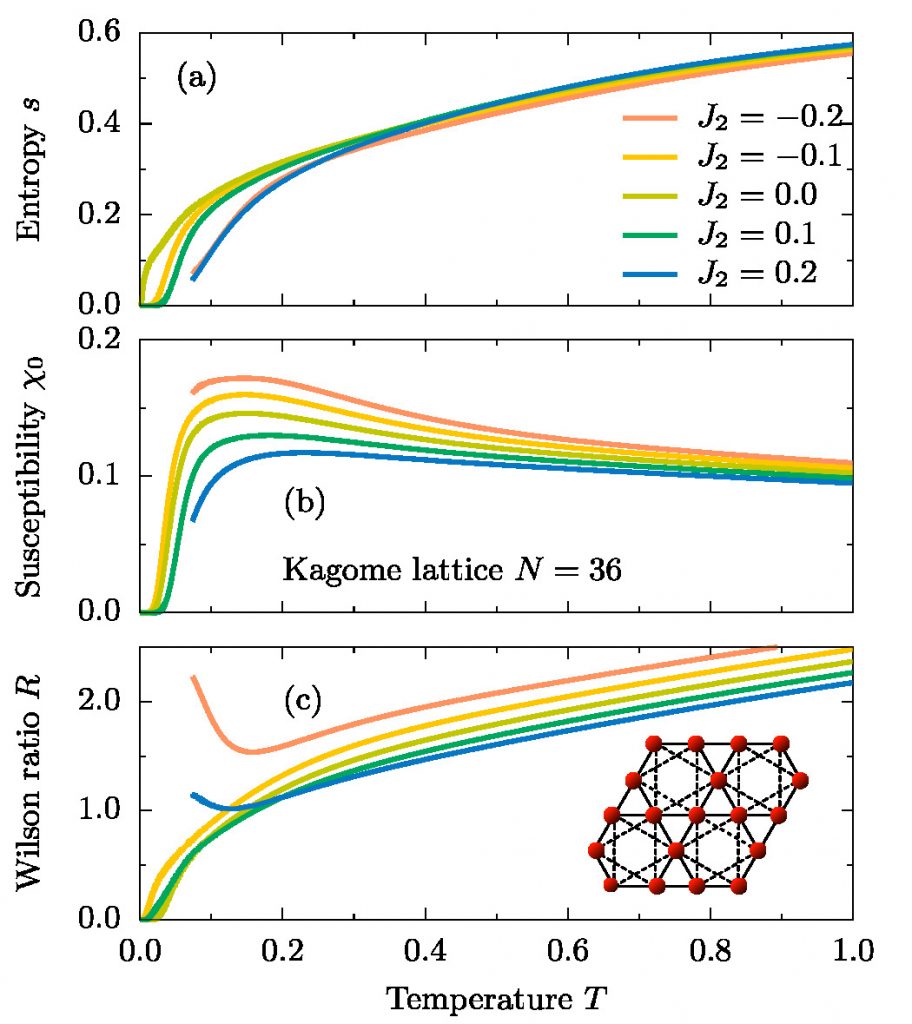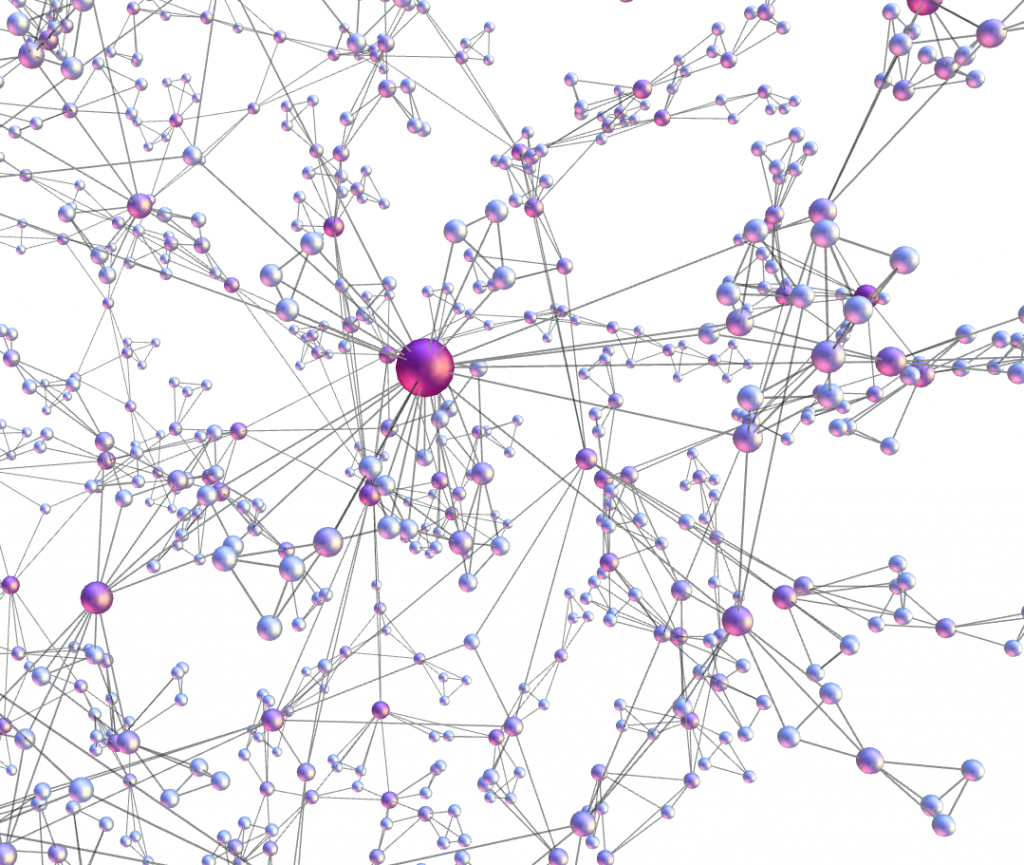- Emission of correlated jets from a driven matter-wave soliton in a quasi-one-dimensional geometry
Tadej Mežnaršič, Rok Žitko, Tina Arh, Katja Gosar, Erik Zupanič, and Peter Jeglič
Phys. Rev. A 101, 031601 (2020)
- Large-scale influence of defect bonds in geometrically constrained self-assembly
Bosiljka Tadic, Milovan Suvakov, Miroslav Andjelkovic, and Geoff J. Rodgers
Phys. Rev. E 102, 032307 (2020)
- Magnetisation Processes in Geometrically Frustrated Spin Networks with Self-Assembled Cliques
Bosiljka Tadic, Miroslav Andjelkovic, Milovan Suvakov, and Geoff J. Rodgers
Entropy 22, 336 (2020)
- The topology of higher-order complexes associated with brain hubs in human connectomes
M. Andjelkovic, B. Tadic, and R. Melnik
Scientific Reports 10, 17320 (2020)
- Resistivity and its fluctuations in disordered many-body systems: From chains to planes
M. Mierzejewski, M. Środa, J. Herbrych, and P. Prelovšek
Phys. Rev. B 102, 161111 (2020)
- Superconductivity emerging upon Se doping of the quantum spin liquid $1T\text{\ensuremath{-}}{\mathrm{TaS}}_{2}$
Izidor Benedičič, Nejc Janša, Marion van Midden, Peter Jeglič, Martin Klanjšek, Erik Zupanič, Zvonko Jagličić, Petra Šutar, Peter Prelovšek, Dragan Mihailovič, and Denis Arčon
Phys. Rev. B 102, 054401 (2020)
- Origin of Magnetic Ordering in a Structurally Perfect Quantum Kagome Antiferromagnet
T. Arh, M. Gomilšek, P. Prelovšek, M. Pregelj, M. Klanjšek, A. Ozarowski, S. J. Clark, T. Lancaster, W. Sun, J.-X. Mi, and A. Zorko
Phys. Rev. Lett. 125, 027203 (2020)
- Vanishing Wilson ratio as the hallmark of quantum spin-liquid models
P. Prelovšek, K. Morita, T. Tohyama, and J. Herbrych
Phys. Rev. Research 2, 023024 (2020)
- Similarity of thermodynamic properties of the Heisenberg model on triangular and kagome lattices
P. Prelovšek and J. Kokalj
Phys. Rev. B 101, 075105 (2020)
- Modeling latent infection transmissions through biosocial stochastic dynamics
Bosiljka Tadic and Roderick Melnik
PLOS ONE 15, 1 (2020)
- Spectral function of the Holstein polaron at finite temperature
J. Bonča, S. A. Trugman, and M. Berciu
Phys. Rev. B 100, 094307 (2019)
- Einstein Relation for a Driven Disordered Quantum Chain in the Subdiffusive Regime
M. Mierzejewski, P. Prelovšek, and J. Bonča
Phys. Rev. Lett. 122, 206601 (2019)
- Functional Geometry of Human Connectomes
B. Tadic, M. Andjelkovic, and R. Melnik
Scientific Reports 9, 12060 (2019)
- Spectral properties of hyperbolic nanonetworks with tunable aggregation of simplexes
Marija Mitrovic Dankulov, Bosiljka Tadic, and Roderick Melnik
Phys. Rev. E 100, 012309 (2019)
- Mottness collapse without metallisation in the domain walls of triangular-lattice Mott insulator 1T-TaS2
J. Skolimowski, Ya. Gerasimenko, and R. Žitko
Phys. Rev. Lett. 122, 036802 (2019)
- Kondo screening in a charge-insulating spinon metal
M. Gomilšek, R. Žitko, M. Klanjšek, M. Pregelj, C. Baines, Y. Li, Q. M. Zhang, and A. Zorko
Nature Phys. 15, 754 (2019)
- Suppressed energy transport in the strongly disordered Hubbard chain
Maciej Kozarzewski, Marcin Mierzejewski, and Peter Prelovšek
Phys. Rev. B 99, 241113 (2019)
- Einstein Relation for a Driven Disordered Quantum Chain in the Subdiffusive Regime
M. Mierzejewski, P. Prelovšek, and J. Bonča
Phys. Rev. Lett. 122, 206601 (2019)
- Instability of subdiffusive spin dynamics in strongly disordered Hubbard chain
M. Środa, P. Prelovšek, and M. Mierzejewski
Phys. Rev. B 99, 121110 (2019)
- Hidden geometries in networks arising from cooperative self-assembly
M. Suvakov, M. Andjelkovic, and B. Tadic
Scientific Reports 8, 1987 (2018)
- {Yu-Shiba-Rusinov} screening of spins in double quantum dots
K. Grove-Rasmussen, G. Steffensen, A. Jellinggaard, M. H. Madsen, R. Žitko, J. Paaske, and J. Nygård
Nat. Commun. 9, 2376 (2018)
- Supercurrent in a Double Quantum Dot
J. C. Estrada Saldaña, A. Vekris, G. Steffensen, R. Žitko, P. Krogstrup, J. Paaske, K. Grove-Rasmussen, and J. Nygård
Phys. Rev. Lett. 121, 257701 (2018)
- Transient and persistent particle subdiffusion in a disordered chain coupled to bosons
P. Prelovšek, J. Bonča, and M. Mierzejewski
Phys. Rev. B 98, 125119 (2018)
- Finite-temperature properties of the extended Heisenberg model on a triangular lattice
P. Prelovšek and J. Kokalj
Phys. Rev. B 98, 035107 (2018)
- Spin Subdiffusion in the Disordered Hubbard Chain
Maciej Kozarzewski, Peter Prelovšek, and Marcin Mierzejewski
Phys. Rev. Lett. 120, 246602 (2018)
- Counting local integrals of motion in disordered spinless-fermion and Hubbard chains
Marcin Mierzejewski, Maciej Kozarzewski, and Peter Prelovšek
Phys. Rev. B 97, 064204 (2018)
- Reduced-basis approach to many-body localization
P. Prelovšek, O. S. Barišić, and M. Mierzejewski
Phys. Rev. B 97, 035104 (2018)
- Complete Many-Body Localization in the $t\text{\ensuremath{-}}J$ Model Caused by a Random Magnetic Field
Gal Lemut, Marcin Mierzejewski, and Janez Bonča
Phys. Rev. Lett. 119, 246601 (2017)
- Mechanisms of self-organized criticality in social processes of knowledge creation
Bosiljka Tadic, Marija Mitrovic Dankulov, and Roderick Melnik
Phys. Rev. E 96, 032307 (2017)
- Self-consistent approach to many-body localization and subdiffusion
P. Prelovšek and J. Herbrych
Phys. Rev. B 96, 035130 (2017)
- Density correlations and transport in models of many-body localization
P. Prelovsek, M. Mierzejewski, O. Barisic, and J. Herbrych
Annalen der Physik 1600362, 1 (2017)
- A high-temperature quantum spin liquid with polaron spins
Martin Klanjšek, Andrej Zorko, Rok Žitko, Jernej Mravlje, Zvonko Jagličić, Pabitra Kumar Biswas, Peter Prelovšek, Dragan Mihailovic, and Denis Arčon
Nature Physics 13, 1130 (2017)
- Nature of Bosonic Excitations Revealed by High-Energy Charge Carriers
Jan Kogoj, Marcin Mierzejewski, and Janez Bonča
Phys. Rev. Lett. 117, 227002 (2016)
- Algebraic Topology of Multi-Brain Connectivity Networks Reveals Dissimilarity in Functional Patterns during Spoken Communications
Bosiljka Tadic, Miroslav Andjelkovic, Biljana Mileva Boshkoska, and Zoran Levnajic
PLOS ONE 11, 1 (2016)
- Universal dynamics of density correlations at the transition to the many-body localized state
M. Mierzejewski, J. Herbrych, and P. Prelovšek
Phys. Rev. B 94, 224207 (2016)
- Absence of full many-body localization in the disordered Hubbard chain
P. Prelovšek, O. S. Barišić, and M. Žnidarič
Phys. Rev. B 94, 241104 (2016)
- Decay of density waves in coupled one-dimensional many-body-localized systems
Peter Prelovšek
Phys. Rev. B 94, 144204 (2016)
- Dynamical conductivity and its fluctuations along the crossover to many-body localization
Osor S. Barišić, Jure Kokalj, Ivan Balog, and Peter Prelovšek
Phys. Rev. B 94, 045126 (2016)
- Distinctive response of many-body localized systems to a strong electric field
Maciej Kozarzewski, Peter Prelovšek, and Marcin Mierzejewski
Phys. Rev. B 93, 235151 (2016)
- Snapshots of the retarded interaction of charge carriers with ultrafast fluctuations in cuprates
S. Dal Conte, L. Vidmar, D. Golež, M. Mierzejewski, G. Soavi, S. Peli, F. Banfi, G. Ferrini, R. Comin, B. M. Ludbrook, L. Chauviere, N. D. Zhigadlo, H. Eisaki, M. Greven, S. Lupi, A. Damascelli, D. Brida, M. Capone, J. Bonča, G. Cerullo, and C. Giannetti
Nature Physics 11, 421 (2015)
- Holon-doublon binding as the mechanism for the Mott transition
Peter Prelovšek, Jure Kokalj, Zala Lenarčič, and Ross H. McKenzie
Phys. Rev. B 92, 235155 (2015)
- Approximate conservation laws in perturbed integrable lattice models
Marcin Mierzejewski, Tomaž Prosen, and Peter Prelovšek
Phys. Rev. B 92, 195121 (2015)
- Exciton recombination in one-dimensional organic Mott insulators
Zala Lenarčič, Martin Eckstein, and Peter Prelovšek
Phys. Rev. B 92, 201104 (2015)
- Spin and thermal conductivity in a classical disordered spin chain
B. Jenčič and P. Prelovšek
Phys. Rev. B 92, 134305 (2015)
- Antiferromagnetic order in weakly coupled random spin chains
J. Kokalj, J. Herbrych, A. Zheludev, and P. Prelovšek
Phys. Rev. B 91, 155147 (2015)
- Identifying Local and Quasilocal Conserved Quantities in Integrable Systems
Marcin Mierzejewski, Peter Prelovšek, and Tomaž Prosen
Phys. Rev. Lett. 114, 140601 (2015)
- Charge recombination in undoped cuprates
Zala Lenarčič and Peter Prelovšek
Phys. Rev. B 90, 235136 (2014)
- Energy and particle currents in a driven integrable system
D. Crivelli, P. Prelovšek, and M. Mierzejewski
Phys. Rev. B 90, 195119 (2014)
- Memory function approach to in-plane anisotropic resistivity in the antiferromagnetic phase of iron arsenide superconductors
Koudai Sugimoto, Peter Prelovšek, Eiji Kaneshita, and Takami Tohyama
Phys. Rev. B 90, 125157 (2014)
- Multistage dynamics of the spin-lattice polaron formation
Jan Kogoj, Zala Lenarčič, Denis Golež, Marcin Mierzejewski, Peter Prelovšek, and Janez Bonča
Phys. Rev. B 90, 125104 (2014)
- Peltier effect in strongly driven quantum wires
M. Mierzejewski, D. Crivelli, and P. Prelovšek
Phys. Rev. B 90, 075124 (2014)
- Breakdown of the Generalized Gibbs Ensemble for Current-Generating Quenches
Marcin Mierzejewski, Peter Prelovšek, and Tomaž Prosen
Phys. Rev. Lett. 113, 020602 (2014)
- Effective $S=\frac{1}{2}$ description of the $S=1$ chain with strong easy-plane anisotropy
C. Psaroudaki, J. Herbrych, J. Karadamoglou, P. Prelovšek, X. Zotos, and N. Papanicolaou
Phys. Rev. B 89, 224418 (2014)
- Optical response of highly excited particles in a strongly correlated system
Zala Lenarčič, Denis Golež, Janez Bonča, and Peter Prelovšek
Phys. Rev. B 89, 125123 (2014)
- Co-Evolutionary Mechanisms of Emotional Bursts in Online Social Dynamics and Networks
Bosiljka Tadic, Vladimir Gligorijevic, Marija Mitrovic, and Milovan Suvakov
Entropy 15, 5084 (2013)
- Local Spin Relaxation within the Random Heisenberg Chain
J. Herbrych, J. Kokalj, and P. Prelovšek
Phys. Rev. Lett. 111, 147203 (2013)
- Ultrafast Charge Recombination in a Photoexcited Mott-Hubbard Insulator
Zala Lenarčič and Peter Prelovšek
Phys. Rev. Lett. 111, 016401 (2013)
- Eigenvalue Statistics of Reduced Density Matrix during Driving and Relaxation
M. Mierzejewski, T. Prosen, D. Crivelli, and P. Prelovšek
Phys. Rev. Lett. 110, 200602 (2013)
- Eigenstate thermalization within isolated spin-chain systems
R. Steinigeweg, J. Herbrych, and P. Prelovšek
Phys. Rev. E 87, 012118 (2013)
- Relaxation Dynamics of the Holstein Polaron
Denis Golež, Janez Bonča, Lev Vidmar, and Stuart A. Trugman
Phys. Rev. Lett. 109, 236402 (2012)
- Spin hydrodynamics in the $S=\frac{1}{2}$ anisotropic Heisenberg chain
J. Herbrych, R. Steinigeweg, and P. Prelovšek
Phys. Rev. B 86, 115106 (2012)
- Coexistence of anomalous and normal diffusion in integrable Mott insulators
R. Steinigeweg, J. Herbrych, P. Prelovšek, and M. Mierzejewski
Phys. Rev. B 85, 214409 (2012)
- Dielectric Breakdown in Spin-Polarized Mott Insulator
Zala Lenarčič and Peter Prelovšek
Phys. Rev. Lett. 108, 196401 (2012)
- Quantitative analysis of bloggers' collective behavior powered by emotions
Marija Mitrovic, Georgios Paltoglou, and Bosiljka Tadic
Journal of Statistical Mechanics: Theory and Experiment 2011, P02005 (2011)
- Finite-temperature Drude weight within the anisotropic Heisenberg chain
J. Herbrych, P. Prelovšek, and X. Zotos
Phys. Rev. B 84, 155125 (2011)
- Integrable Mott Insulators Driven by a Finite Electric Field
Marcin Mierzejewski, Janez Bonča, and Peter Prelovšek
Phys. Rev. Lett. 107, 126601 (2011)
- Nonequilibrium Quantum Dynamics of a Charge Carrier Doped into a Mott Insulator
M. Mierzejewski, L. Vidmar, J. Bonča, and P. Prelovšek
Phys. Rev. Lett. 106, 196401 (2011)
- Nonequilibrium dynamics of the Holstein polaron driven by an external electric field
Lev Vidmar, Janez Bonča, Marcin Mierzejewski, Peter Prelovšek, and Stuart A. Trugman
Phys. Rev. B 83, 134301 (2011)
- Modeling collective charge transport in nanoparticle assemblies
Milovan Suvakov and Bosiljka Tadic
Journal of Physics: Condensed Matter 22, 163201 (2010)
- Nonlinear Current Response of an Isolated System of Interacting Fermions
Marcin Mierzejewski and Peter Prelovšek
Phys. Rev. Lett. 105, 186405 (2010)
- Conductivity in a disordered one-dimensional system of interacting fermions
O. S. Barišić and P. Prelovšek
Phys. Rev. B 82, 161106 (2010)
- Dynamical central peak and spinon deconfinement in frustrated spin chains
J. Kokalj and P. Prelovšek
Phys. Rev. B 82, 060406 (2010)
- Thermal transport in a spin-$\frac{1}{2}$ Heisenberg chain coupled to a magnetic or nonmagnetic impurity
A. Metavitsiadis, X. Zotos, O. S. Barišić, and P. Prelovšek
Phys. Rev. B 81, 205101 (2010)
- Phenomenological theory of the anomalous normal-state transport properties of iron pnictides
P. Prelovšek and I. Sega
Phys. Rev. B 81, 115121 (2010)
|
